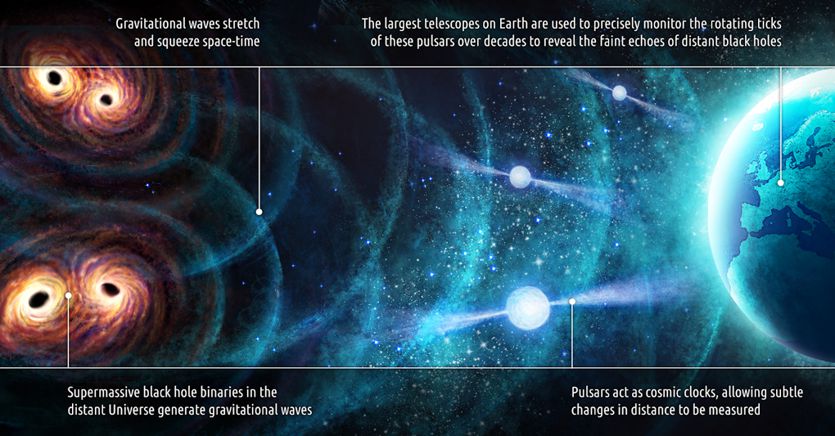Listen to the audio version of the article
They call it “the breath of the universe”, it is the background noise that astronomers have been able to hear thanks to a technique for detecting gravitational waves. A novelty which, as they underline, opens a “new window on the universe”. An important result, published in The Astrophysical Journal Letter, the result of a study and research project that saw the collaboration of several scientists. Scientists have observed for the first time the faint ripples caused by the movement of black holes that are gently stretching and compressing everything in the universe.
On Wednesday, they reported that they were able to “feel” what they call low-frequency gravitational waves, “changes in the fabric of the universe created by huge objects moving and colliding in space.” The first time, as pointed out by Maura McLaughlin, co-director of NANOGrav, North American Nanohertz Observatory for Gravitational Waves that “we have evidence of this large-scale movement of everything in the universe”. To explain how important this discovery is Michele Vallisneri, senior research scientist at NASA’s Jet Propulsion Laboratory in Southern California.
Meloni: with Einstein Telescope Italy and the EU in step with global players
“This discovery reveals that the entire universe is immersed in a background noise of gravitational waves, coming from binaries of black holes at the center of galaxies, and suggests that these binaries exist in large numbers,” he says. The detection technique is almost unbelievable: we monitored for 15 years the regular pulsation coming from 67 neutron stars in the galaxy, to measure the stretching and compression of spacetime». Europe has made an important contribution to the discovery of very low-frequency and ultra-long gravitational waves, with the European Pulsar Timing Array (EPTA) collaboration, and Italy, thanks to the National Institute of Astrophysics, with its headquarters in Cagliari, and the University of Milan Bicocca. The result is due to 13 telescopes from all over the world. Of these, 5 are European, including the Sardinia Radio Telescope.
Within the 11 European institutions that are part of EPTA, astronomers and theoretical physicists have collaborated to use the data relating to 15 pulsars, very dense stars that rotate on themselves, whose rhythm is altered by the passage of new gravitational waves. Distant from Earth and scattered throughout the Milky Way, pulsars have become a single cosmic detector bordering on science fiction. The variations in their rotation measured by the 13 radio telescopes in fact reflect the expansions and compressions of space-time, whose regularity recalls that of breathing. The European organization has participated in a large teamwork with Indian and Japanese researchers of the Indian Pulsar Timing Array (InPta) and other pulsar hunters active in the world, such as the North American collaboration NanoGrav, the Australian Ppta and the Chinese CPTA .
Along with the Sardinia RadioTelescope, the radio telescopes that allowed the discovery are the Effelsberg Radio Telescope in Germany, the Lovell Telescope of the Jodrell Bank Observatory in the United Kingdom, the Nancay Radio Telescope in France and the Westerbork Radio Synthesis Telescope in the Netherlands. According to the president of the National Institute of Astrophysics, Marco Tavani, these are “extraordinary results for their scientific importance and for the future prospects of further consolidation of the results”. The newly published results, he notes, are “a milestone for contemporary astrophysics: on the one hand they open a new observational window in the science of gravitational waves and on the other they confirm the existence of ultra-long gravitational waves which, according to current theories, they should be generated by pairs of super-massive black holes formed during the merging process between galaxies”.
